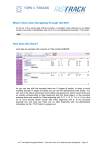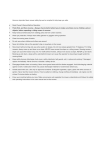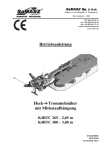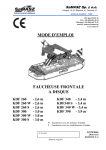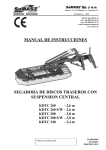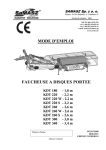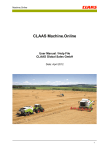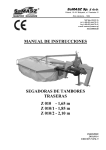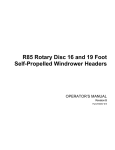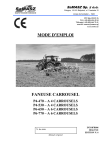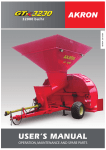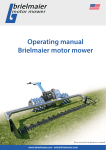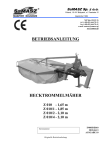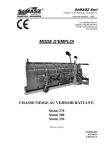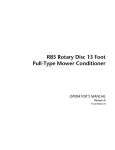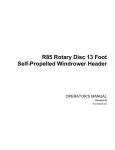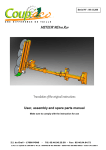Download IN0670EN001 - 2014-01-20 - SAMBA - str. 1-2
Transcript
SaMASZ Sp. z o.o. Poland, 15-161 Białystok, ul. Trawiasta 15 Established – 1984 NIP 966-159-29-76 tel. (+48) (85) 654 45 84 fax (+48) (85) 664 70 41 e-mail: [email protected] www.samasz.pl OPERATOR'S MANUAL REAR DISK MOWER SAMBA 160 SAMBA 200 SAMBA 240 SAMBA 280 – 1.6 m – 2.0 m – 2.4 m – 2.8 m IN0670EN001 2014.01.20 EDITION NO. 1 Nr. Serial no. Original manual It is recommended to incline cutterbar up to angle of 3° in relation to mowing direction. Operating in horizontal position is admissible. DO NOT TURN THE DRIVE ON UNLESS THE MOWER IS IN ITS WORKING POSITION DO NOT OPERATE THE MOWER WITH UNAUTHORIZED PERSONNEL PRESENT WITHIN 50 M OR LESS NOTE: Keep this manual for future reference. Written by: mgr inż. Jakub Gościk User's manual Light rear disk mowers SAMBA Table of contents page 1. IDENTIFYING THE MACHINE ............................................................................................... 2 2. INTRODUCTION......................................................................................................................... 2 3. DESIGNATION ............................................................................................................................ 3 3.1. Technical data .......................................................................................................................................... 3 3.2. Design and operating principle ................................................................................................................ 4 3.3. Standard equipment and spare parts ........................................................................................................ 4 4. SAFETY ADVICE AND WARNING ......................................................................................... 5 4.1. Safety rules and regulations ..................................................................................................................... 5 4.2. Conditions of mounting mower on tractor............................................................................................... 7 4.3. Transport .................................................................................................................................................. 7 4.3.1. Relocating mower onto another vehicle for transport ........................................................................ 8 4.4. Operating parts ........................................................................................................................................ 9 4.5. PTO shaft ................................................................................................................................................. 9 4.6. Hydraulic assembly ................................................................................................................................. 9 4.7. Residual risk .......................................................................................................................................... 10 4.8. Safety decals and their meaning ............................................................................................................ 11 4.9. Operation and design of safety breakaway device................................................................................. 13 5. MOWER'S OPERATION.......................................................................................................... 14 5.1. Mounting mower on tractor ................................................................................................................... 14 5.2. Preparing mower for transport ............................................................................................................... 15 5.3. Preparing mower for transport on public roads ..................................................................................... 16 5.4. Mounting PTO shaft .............................................................................................................................. 16 5.5. Switching the mower from transport to working position ..................................................................... 17 5.6. Preparing mower for operation .............................................................................................................. 18 5.7. Operation ............................................................................................................................................... 18 5.7.1. Basic information on mowing .......................................................................................................... 18 5.7.2. Mower clogging................................................................................................................................ 19 5.7.3. Driving with mower over windrows when taking turns ................................................................... 19 5.8. Dismounting mower from tractor .......................................................................................................... 19 6. MOUNTING AND ADJUSTMENTS ....................................................................................... 20 6.1. Mounting knives .................................................................................................................................... 20 6.2. Replacing knives.................................................................................................................................... 21 6.3. Adjusting cutting height ........................................................................................................................ 22 6.4. Operating service ................................................................................................................................... 22 6.4.1. Controlling condition of knives and knife holders ........................................................................... 22 6.4.2. Controlling tension of V-belts for belt gear...................................................................................... 23 6.4.3. Daily maintenance ............................................................................................................................ 23 6.4.4. Off-season maintenance and storing................................................................................................. 23 7. LUBRICATING .......................................................................................................................... 24 7.1. Cutterbar ................................................................................................................................................ 24 7.2. Intersecting axis gear ............................................................................................................................. 25 8. 9. DEFECTS AND THEIR REPAIR ............................................................................................ 26 REPAIR AND WITHDRAWAL FROM USE ......................................................................... 27 9.1. Repair..................................................................................................................................................... 27 9.2. Withdrawal from use ............................................................................................................................. 27 10. WARRANTY CARD .................................................................................................................. 27 11. WARRANTY TERMS ............................................................................................................... 28 11.1. Warranty claim procedure ..................................................................................................................... 28 11.2. Warranty repairs record ......................................................................................................................... 29 -1- Light rear disk mowers SAMBA User's manual 1. IDENTIFYING THE MACHINE Data plate is permanently mounted to the mower's main frame in place shown below on Fig. 1. Fig. 1. Data plate placement Data plate includes: - name of the manufacturer, - mower serial number, - mower symbol, - date of manufacture, - weight, - version no., - quality management sign, - CE marking, means that mower is conforming with Directive 2006/42/EC and harmonized standards, - MADE IN POLAND sign, - barcode. NOTE: In case the operator's manual is unclear or illegible all necessary information can be obtained from manufacturer or the dealer. 2. INTRODUCTION This operator's manual should be considered the mower's basic equipment and should be kept for further reference. If the mower is handed over to another operator, it should be in working condition, along with operator's manual, declaration of conformity and its basic equipment. Prior to operating the mower its user must familiarize himself with contents of this manual as well as common work safety rules. The mower is manufactured in accordance with safety standards requirements. Respecting recommendations herein shall ensure full operation safety. If you have any questions concerning commissioning and operating the mower, please contact the manufacturer. Operator's manual remains an integral part of the mower equipment. GENERAL PRECAUTION When operating the mower warnings and safety rules marked with this sign herein should be respected. NOTE: Operating the mower without previous familiarizing with its contents as well as by unauthorized personnel, particularly by children, is strictly forbidden. -2- Light rear disk mowers SAMBA User's manual 3. DESIGNATION Light class rear disk mowers SAMBA are designed to operate on smaller farms, and are used for mowing standing grass: common grass, medick, etc on meadows and on stone free fields as well as forming swath out of these. They do well in mountainous as well as swamp areas, where the machine's and tractor's weight is of great importance. Application of innovative suspension assembly allows for adjusting optimal pressure of cutterbar onto the ground. Meadows or fields to be mowed should be even, previously prepared by rolling and other processing. NOTE: Use of the mower for purposes other than mentioned herein is forbidden. Different use than the above mentioned shall be considered as improper and may lead to revoking of the warranty. The mower should be operated, maintained and repaired only by personnel who are familiarized with its detailed specifications and safety rules and procedures. Willful modifications to the mower may lead to revoking the warranty. NOTE: SAMBA mowers are not fully resistant to stones and therefore when operating on a stony field, it is highly likely, that disks might be replaced frequently or in extreme case, cutterbar might be seriously damaged, which is NOT COVERED by free warranty servicing. 3.1. Technical data Tab. 1. Technical data Mower type: Working width [m] Number of knives [pcs] Number of disks [pcs] Tractor's PTO rears [rpm] Cooperating tractor power [HP] Operating capacity [ha/h] Transport length [mm] Transport width [mm] Width in working assembly [mm] Transport height [mm] Weight [kg] Cutting speed of knife [m/s] Rotational speed of disks [rpm] 3-point linkage category SAMBA 160 SAMBA 200 SAMBA 240 SAMBA 280 1.60 8 4 2.00 10 5 2.40 12 6 2.80 14 7 from 20 ~ 1.5 from 30 ~ 2.0 from 45 ~ 2.5 from 60 ~ 3.0 4230 2900 490 4504 3280 530 540 1782 1695 3680 2140 410 3956 2520 450 83 3115 II II 77,0 ± 3,0 dB 76,0 ± 3,0 dB 98,5 ± 3,0 dB LpA – noise level related to 8 hour working time. Averaged in time acoustic pressure level corrected by frequency characteristic A. LAmax – maximum value corrected by frequency characteristic A of acoustic pressure level. LCpeak – peak level of acoustic pressure corrected by frequency characteristic C. Noise level II II LpA LAmax LCpeak -3- Light rear disk mowers SAMBA User's manual 3.2. Design and operating principle 1 2 3 5 4 6 7 8 Fig. 2. Overview of rear disk mower SAMBA 1 – Linkage 2 – Cylinder with support spring 3 – Belt gear 4 – Cutterbar 5 – Swath guide 6 – Safety guard 7 – Disk type swath guide (option) 8 – 3-point linkage frame Linkage (1) allows mounting mower on tractor's 3-point linkage. Drive from tractor's PTO is transmitted by belt gear (3) onto LiteCUT cutterbar (4). Hydraulic lifting cylinder (2) fed from the tractor external hydraulics is used to adjust the mower to working position. 3-point linkage frame (8), onto which spring suspended cutterbar is set. The frame has also swath guides (5), which are standarddelivered, optional disk type guides (7) and protective guard (6). Well-proven design and quality materials ensure high reliability and durability of SaMASZ machines. 3.3. Standard equipment and spare parts Mowers are sold with the following standard equipment: warranty card, operator's manual with spare part list, cutting knives: extra set, PTO shaft with overrunning clutch, spray paint (150 ml). Optional equipment (on extra charge): warning plates with combined lights and reflectors, warning triangle, double rubber guide. -4- Light rear disk mowers SAMBA User's manual Tab. 2. Recommended PTO shaft Mower SAMBA 160 SAMBA 200 SAMBA 240 SAMBA 280 Ref Clutch Manufactur er mm Moment um Nm 660-900 460 7G3N066CE007096MA Right-hand overrunning BONDIOLI & PAVESI Power Length HP 35 PTO shaft end without clutch – To be mounted on the tractor side 50 h 50 h 50 h Remarks PTO shaft end with right overrunning clutch – To be mounted from the mower side 50 h Fig. 3. Shaft lubrication instructions. Shaft connection NOTE: PTO shaft lubrication frequency must be respected. Points marked on Fig. 3 shall be lubricated every 50 hours. PTO shaft should also be lubricated prior to and after longer idle period. PTO shafts of other brands with equivalent technical parameters may be used on the SaMASZ permission. NOTE: Optional equipment should be ordered separately. The mower is equipped with such elements as holders and brackets used to mount required warning lights and plates. Combined lights and reflectors are mounted on the warning plates. We congratulate you on the purchase of your new SaMASZ mower and wish you much pleasure and the very best experience resulting from its operation. 4. SAFETY ADVICE AND WARNING 4.1. Safety rules and regulations Front axis of the tractor should be loaded by a minimum of 20% of tractor's overall weight to keep the balance. If need be, use front wheel weights. Any operation with the hydraulic lift lever should be conducted from the operator's seat; DO NOT move the lever from outside of the tractor. In case of tractors equipped with EHR, controlling with hydraulic lift is conducted with a button located outside the tractor's cabin. When operating, please be extremely careful. When switching from working to transport position the whole or at least one end (from tractor's spline shaft side) of PTO shaft should be dismounted. -5- User's manual Light rear disk mowers SAMBA Examine condition of guards and its mounting on regular basis. Operating without safety guards is not permitted. Neither operation with damaged or raised guard is permitted (danger of stones, etc. being thrown out). Damaged protective apron should be replaced with a new one. Start mowing only when the tractor's spline shaft reaches its nominal value of 540 rpm. DO NOT exceed value of 600 rpm for spline shaft. No unauthorized personnel is allowed to remain within the danger area of at least 50 m. Keep particular caution when operating near roads and in stony areas. Any maintenance and adjustment work is allowed only with the drive disconnected and the cutting disks in complete standstill and wearing protective gloves and appropriate tools. Condition of knives should be examined each time before commencing any operation. Damaged or worn knife holders must be replaced. When driving on public roads always respect the local traffic regulations concerning warning -lights, while the mower shall be equipped with required safety devices. When transported the mower shall have remote warning light device and warning triangle mounted. NOTE: Any service and repair operations must be conducted with the tractor drive disconnected and ignition key out, cutterbar lifted onto the ground while all rotating parts in the complete standstill. Caution! Cutting knives keep rotating for several minutes after the engine is stopped. NOTE: Keep the children away from the mower both in operation and standstill. When the mower is lifted for repair on the 3-point linkage, it should be protected against accidental falling by a mechanical support or by chain. Bolts and other fasteners should be inspected on regular basis. Operating with damaged or worn fasteners is not admissible. Locking pawl line should be mounted with relevant tolerance in the tractor cabin. When operating the mower, please comply with the Resolution of the Minister of Agriculture and Food Economy of 12-01-1998 on work safety when operating tractors, machines, technical instruments and devices used in farming Dz. U. nr 12/98 poz. 51. When operating the mower, the tractor should always be equipped with operator's cabin. Mower should not be operated when the cooperating tractor is not well balanced. The mower shall never be started when it is lifted up. The mower shall never be started, with persons or animals near the machine. Prior to starting the mower, make sure there are no animals underneath the tarpaulin cover. The safety guard shall never be lifted until rotating assemblies are in complete standstill. Tractor's engine must be turned off. Caution! Cutting knives keep rotating for several minutes after the engine is stopped. Always comply with safety decals describing hazards, and warning signs placed on the machine. Before starting the tractor make sure that each drive is disconnected while the hydraulics control levers are in neutral position. Do not let the tractor's engine operate without any supervision. Before leaving the tractor, turn the engine off and take the ignition key out. It is forbidden to drive the mower backwards when operating. Never get onto the mower. -6- User's manual Light rear disk mowers SAMBA Lifting the mower on the tractor 3-point linkage with the drive on and the disks rotating is not permitted. For operating and transport drive permissible slope shall be 8°. Never stand between the tractor and the mower, unless tractor-mower aggregate is protected against moving with the tractor's parking brake. Any maintenance checkups and regulations may be conducted only when the mower is disassembled and on the ground. If any maintenance or adjustment works under the lifted mower are necessary, it must be secured against falling with a support. If any part of the mower needs to be replaced, use only genuine spare parts according to catalogue of spare parts. Pay particular attention to both PTO shaft and spline shaft guards. Never operate with damaged guards. Hydraulic hoses should be inspected on regular basis and if any damage is found or they expire, replace these with new ones. Expiry period for hydraulic hose should be no longer than 5 years. Never use scotch tape to repair damaged hydraulic hoses. When connecting hydraulic hoses to tractor hydraulic connectors make sure, that either tractor or mower hydraulics are pressure free. When servicing hydraulic assembly, always wear protective gloves and eyewear. Hydraulic oil leaking under pressure (16 MPa) may permeate through the skin and cause its infection thereafter. If such is experienced, immediately visit a doctor. The mower should be stored under roof and in manner that effectively prevents animals and persons from being injured. Operating without safety guards is not permitted. Neither operation with damaged or raised guard is permitted (danger of stones, etc. being thrown out). Damaged protective apron should be replaced with a new one. When operating the mower, control damages to structures, protective aprons, chains, rubber elements and if need be, replace these with new ones, even not completely worn out elements. When mounting the mower on a tractor, danger of wounding is present. It is recommended for the operator to wear protective gloves. In the event of fatal failure, please call for technical service, and if an accident (in this case: road accident) occurs, respect first aid rules and contact responsible authorities. Mower should be kept clean, so as to avoid danger of fire. Do not leave agricultural machinery on slopes or other descents without providing protection against its free runaway. 4.2. Conditions of mounting mower on tractor Prior to the mounting operation, check whether the tractor's and the mower's hitch categories are compatible and make sure that tractor's hitch load is adequate for the machine aggregated. When mounting the machine, examine technical condition of the mower's hitch assembly and tractor's 3-point linkage. Use only genuine pins and cotters to mount the mower on a tractor. 4.3. Transport Any modifications in the mower's position are possible only if no unauthorized personnel is around (children in particular). -7- User's manual Light rear disk mowers SAMBA When transported the mower shall have mobile warning light device and warning triangle mounted for a slow driving vehicle. When transported the mower should always be set in transport position. See item 5.2. Prior to shifting the mower to transport position make sure, that the tractor PTO is disconnected and all the rotating parts in complete standstill. Driving speed should always be adjusted to current road conditions. Driving speed should always be adjusted to current road conditions and local traffic rules. 4.3.1. Relocating mower onto another vehicle for transport Both the carrier and the driver shall be responsible for the mower's transport safety. Any equipment and parts must be secured properly for transport. In order to safely relocate the mower onto another vehicle, please follow these rules: seize the mower by any lifting device only in places indicated on the machine with the hook sign (Fig. 4), Fig. 4. Mower's catching points to lift the mower, use only lifting devices with hoisting capacity bigger than the mower weight provided on data plate. It also applies to ropes and chains used for lifting, transport belts, belt suspensions, ropes cannot be damaged. Whenever damages to these parts are spotted replace these with new ones, when mounting slings, chains, handles etc. always pay attention to setting the machine's center of gravity properly, to catch machines, pick ropes of adequate length, so that the angle between them is no greater than 120°, and the angle between the strand and the vertical is no greater than 60°, collapsible elements should be locked in transport position, when relocating the mower onto another vehicle, there should be no unauthorized personnel permitted to remain within the danger area, the mower should be protected from shifting on the vehicle's trailer. NOTE: Securing both the danger area and activity performed shall lie under the responsibility of the person in charge of the mower transporting. -8- Light rear disk mowers SAMBA User's manual Fig. 5. Location of centre of gravity for Samba mowers Tab. 3. Location of centre of gravity Mower type Dimension [mm] Samba 160 Samba 200 Samba 240 Samba 280 A 506 510 515 510 B -61 78 200 358 C 668 706 710 770 4.4. Operating parts Prior to operating the mower check condition of both the knife and the knife holder. Worn or damaged knives or knife holders should be replaced immediately with new ones. 4.5. PTO shaft Prior to operating learn provisions found in bar manufacturer's manual placed on the shaft. Use only the mower's manufacturer recommended PTO shafts featuring guards in good technical condition. In order to operate safely use only fully technically fit, undamaged PTO shafts. Damaged PTO shaft shall be repaired or replaced with new one. Prior to approaching any operation, make sure that PTO rears have proper rotational direction. 4.6. Hydraulic assembly Caution! Hydraulic assembly is under pressure! Hydraulic oil under pressure may permeate through skin and cause serious injury, therefore skin and eyes should be protected in particular. In case of injuries caused by liquid under pressure, call doctor immediately. Hydraulic hoses can be connected to tractor's hydraulics, provided that both the tractor’s and the mower's hydraulic assemblies are not under pressure. To remove the pressure from the hoses just simply restart the tractor's hydraulic valves several times, once the tractor is off. When dismounting the machine from the tractor, set the equipment aside, deflate the pressure from hydraulics and turn tractor's engine off. -9- User's manual Light rear disk mowers SAMBA When inspecting hydraulic assembly's malfunction and looking for oil leaks, it is forbidden to touch any potential leaks until the entire assembly is under pressure. 4.7. Residual risk Despite the fact, that SaMASZ Białystok – the manufacturer of the mower takes the responsibility for the mower design and manufacturing, in order to eliminate hazard, certain risk when operating the mower is unavoidable. Major source of risk follows performance of these operations: operation of mower by minors as well as not being learned with content of the operator's manual, operation of mower by persons under influence of alcohol or other abusive substances, not being cautious while transporting and moving the mower during operation, transport of persons remaining on the machine, presence of persons and animals within the mower's operation range, performing operations related to servicing and adjustment with engine on. 1. Danger of catching This kind of risk occurs when the mower position is changed, when operating near rotating parts operating without safety guards. When operating, maintenance and regulation works are conducted always wear protective gloves, footwear and clothing with no loose parts, belts, etc. Always comply with safety decals placed on the mower. 2. Danger of wound This kind of risk appears when operating parts with sharp edges are being replaced. For any repair and maintenance works always wear safety gloves. 3. Danger of liquid leakage out of hydraulic assembly When connecting hydraulic hoses to and from the tractor hydraulic connectors make sure, that either tractor or mower hydraulics are pressure free. When servicing hydraulic assembly, always wear protective gloves and eyewear. Inspect hydraulic hoses regularly. NOTE: Residual risk results from incorrect behavior of the mower's operator. 4. Bans Bear in mind the following bans when operating the mower: do not remove clogs from the mower, make any adjustments or repairs when the mower is operating, never change the sequence of operation and maintenance works specified in the operator's manual, never operate the mower when it is not in working condition or has safety guards damaged, never get your limbs close to mower's rotating parts, during the mower repair and maintenance works always comply with the descriptions included in the operator's manual, while conducting them with the tractor drive disconnected, prior to approaching any works, focus your attention solely on the tasks to do, never operate the mower being under influence of alcohol, drugs, or strong medicines, wear clothing that is not too loose, nor too tight. Too loose clothing elements may be pulled in by the mower's rotating parts, the mower cannot be operated by children nor handicapped people. When describing residual risk, the mower shall be considered a machine, which until the moment of production launching had been designed and manufactured in accordance with top technology until the day of the mower manufacture. - 10 - User's manual Light rear disk mowers SAMBA NOTE: There is possibility of residual risk if not complying with specified instructions and bans. When the risk of being exposed to noise cannot be avoided or eliminated by any group protective means or organization of work, employer (operator) must: 1) provide the operator with individual means of noise protection, if the noise level in work place exceeds 80 dB. 2) provide the operator with individual means of noise protection and supervise its proper use, if the noise level in work place reaches or exceeds 85 dB. 4.8. Safety decals and their meaning NOTE: a) all warning decals (labels) should be clean and legible, b) lost or damaged decals (labels) must be replaced, c) new decals (labels) may be ordered at the manufacturer. 1. N-1 2. N-2 Be extremely careful when Remark: cutting knives! Do PTO shaft is rotating. not get near to the operating mower 5. N-5 Remark: belt gear, keep particular attention 6. N-6 Remark: pulling-in parts - 11 - 3. N-3 Prior to operation commencement read the operator's manual carefully 4. N-4 Prior to approaching any maintenance or repair works, turn the machine off 7. N-7 Operating the mower is forbidden with presence of any unauthorized personnel within the danger area of 50 m 8. N-29 Light rear disk mowers SAMBA User's manual 9. N-40 Catching point when relocating mower 10. N-49 Never stand near the tractor 3-point linkage when controlling the lift 11. N-50 Do not remain in the mower swinging area 12. N-52 Wear protective gloves 13. N-117 Avoid contact with liquid coming out under pressure 14. N-167 Do not get onto guardrails or protective guards 15. N-168 Do not touch machine parts until all of its assemblies are stopped 16. N-174 18. N-55 20. N-63 17. N-31 19. N-155 21. N-65 22. P-3 23. P-2 24. N-173 - 12 - User's manual Light rear disk mowers SAMBA Fig. 6. Location of warning decals on mower NOTE: Any assembly used for the mower repair should hold all warning decals provided by the manufacturer. 4.9. Operation and design of safety breakaway device ~ 20 ° Upon driving with mower onto an obstacle one of the safety breakaway device's arm is retracted, so as the mower's working assemblies by an angle of approx. 20° (Fig. 8). Operator is then given enough time to stop the tractor and avoid damaging the mower. The safety breakaway device's spring (Fig. 7) with adjustable deflection allows for changing the device's momentum of activation. R Fig. 7. Mower safety breakaway device Fig. 8. Mower retracting upon use of breakaway device Length of pressed safety breakaway device's steel spring (measurement R on Fig. 7) should be R=138 mm, ø 10 mm, D = 37 mm. In the event if breakaway device is loosed often, dimension R shall be reduced by 1÷2 mm. Bear in mind, that too tight the spring tension may cause the breakaway device to be locked, and therefore machine to be damaged. - 13 - Light rear disk mowers SAMBA User's manual 5. MOWER'S OPERATION 5.1. Mounting mower on tractor NOTE: When mounting and dismounting the mower, there should be no persons in between the machine and the tractor. Any accidental maneuvering with the set may cause to crushing of unauthorized personnel. Mower should be mounted on tractor with use of 3-point linkage as provided on Fig. 9. Upon mounting the mower adjust the machine position on even ground with use of upper link (S) and hangers (W) of tractor's lower links. Cutterbar should be inclined towards. Hangers (W) of tractor's lower links should be placed on pins (A) (Fig. 9) of mower's linkage. Connect the mower hydraulic hose to the tractor one-section hydraulic connector. As the mower is mounted to the tractor, examine the longitudinal balance and steering of the tractor-mower aggregate. In order to do this, the set should be weighed and then driven on the scales with the tractor front axis only (the mower must be in transport position, so lifted upwards). If pressure on the front axis is at least 20% of the whole pressure for the aggregate, it means the aggregate is stable. If not, the tractor front axis should be balanced accordingly. S A W A Fig. 9. Mower mounted on tractor NOTE: Prior to dismounting mower from tractor put safety pin (1) into a hole (3) in cutterbar to protect hitch from falling. With mower mounted on place the pin in bushing (2) (Fig. 10a) found on central beam. 2 3 Z 1 a) b) Fig. 10. a) 1 – safety pin, 2 – bushing, 3 – hole in cutterbar, b) Z – locking pawl - 14 - Light rear disk mowers SAMBA User's manual 5.2. Preparing mower for transport NOTE: Prior to shifting the mower to transport position lift up mower's front guard (O) and secure it with pin (S) (Fig. 11) found on the guard's right side. The guard, if not lifted up and improperly protected, may cause serious damages to mower's guard or tractor's elements, e.g. rear lights. O O S S a) b) Fig. 11. Manner of setting front guard for transport In order to prepare the mower lifted on the tractor for transport - on a - road: lift up mower's front guard and secure it with pin, lift the mower with tractor hydraulic lift onto the tractor links until the lower lift pins of the mower 3-point linkage frame are raised about 50 cm above the ground (Fig. 13), remove safety pin (1) and place it in bushing (2) (Fig. 10a), lift the cutterbar vertically with hydraulic cylinder and lock the locking pawl (Z) (Fig. 10b), protect the cutterbar from falling by disconnecting shut-off valve (Z) (Fig. 12b) found on mower's cylinder, dismount PTO shaft from tractor, lift up support leg and secure it with cotter. NOTE: When transporting the machine, shut-off valve lever must be in (Z) position – closed (Fig. 12b). Thanks to this, the mower is protected from accidental dismantling on unexpected motion of both the tractor and the mower – in worst case, it might cause cracks to hydraulic hose and lead to an accident. Z O a) b) Fig. 12. Cylinder valve in position: a) opened O (work), b) closed Z (transport) - 15 - Light rear disk mowers SAMBA User's manual Front guard lifted up for transport 50 cm a) b) 50 cm Fig. 13. Transport position 5.3. Preparing mower for transport on public roads To meet safety precautions concerning transport on the public roads the mower should be equipped with the following devices: portable warning-light plates, consisting of panel mounted in the upper guard socket (to be ordered optionally). The panel consists of warning plate with combined lamp mounted (parking, stop lights and driving direction) and with red reflectors directed to the rear and white light to the front, NOTE: If the mower purchaser does not own the above warning-light plates, these can be ordered at the mower's manufacturer. table for marking slow moving vehicles (being standard tractor equipment), which should be taken from the tractor and placed at the holder located at the belt gear guard. 5.4. Mounting PTO shaft PTO shaft should be mounted with overrunning coupling from the mower side. The guard should be protected against rotating by securing the shaft set chains to immovable parts of the tractor and the mower. NOTE: If need be shorten PTO shaft as provided in corresponding shaft operator's manual (Fig. 14). - 16 - User's manual Light rear disk mowers SAMBA Fig. 14. Shortening PTO shaft instructions NOTE: PTO shafts should be mounted with right overrunning clutch on the mower side. NOTE: Use machines with correspondingly designed telescopic articulated drive shafts. Prior to work commencement, inspect safety guards whether they (in tractor, mower and shaft) are placed correctly and are not damaged. Damaged or missing parts must be replaced with genuine ones. Make sure that the PTO shaft is mounted properly. Approaching the rotating parts is strictly forbidden, as it may lead to serious injuries or even cause death. For any service and repair works of the shaft and the blower, the tractor engine and spline drive must be disconnected. Prior to the operation commencement, read the operator's manuals of both the shaft and the machine. 5.5. Switching the mower from transport to working position NOTE: Switching the mower from operating position to transport position and vice versa could only take place on even and stable ground. Prior to approaching works, make sure whether there are no unauthorized persons exposed to getting crushed. open the shut-off valve on the cylinder (Fig. 12a), lower the mower onto the tractor's 3-point linkage until the suspension pins of the frame are at height max. of 40 cm above the ground (Fig. 13), make sure there is no person around the danger area, tension the line, so as the locking pawl can be released (Z) (Fig. 10b) and open tractor's external hydraulics to set cutterbar by means of hydraulic cylinder into horizontal position, lower the cutterbar with tractor lever to reach the horizontal position in the slowest way possible, by means of upper link (S) (Fig. 9) set required mowing height. By extending the link (S) the mowing height is increased, while shortening it is reduced. lower mower's front guard. - 17 - User's manual Light rear disk mowers SAMBA 5.6. Preparing mower for operation NOTE: During storing of the machines in company SaMASZ the cylinders are protected by special grease in order to secure them against weather which may cause their premature wear. Before starting the operation excess grease should be removed from the cylinders. Engaging mower’s drive should be performed once cutterbar is placed on the ground. The following should be performed in workplace and as mower is in working position: connect PTO shaft extension onto tractor's spline shaft (unless only one extension was taken out) or connect the complete PTO shaft, optimal angle of cutterbar in relation to the ground should be between 2° and 3°. This angle is result of tightening or extending the link, slowly engage the mower's PTO shaft drive up to 500 ÷ 540 rpm until cutting discs reach their nominal rotating speed, engage proper tractor gear and start mowing. Even meadows can be mowed at any driving speed, but more than 8 km/h, however as unevenness occurs the speed should be reduced. NOTE: Improperly relieved cutting unit of the mower will cause increase of cutterbar pressure on the ground which will lead to faster wear of sliding skids, overload of cutterbar, higher fuel consumption, damage to the stubble and contamination of the fodder. 5.7. Operation 5.7.1. Basic information on mowing Dear User, If mowing has been performed with use of a double-drum mower, then the following recommendations and remarks should be taken into consideration: stubble after mowing looks different than in case of double-drum mowers. If mower is inclined by approx. 2° to 3°, then the stubble line is wavy. When mowing in horizontal manner, although the line seems to be straight, but due to the fact, that cutting knives are operating horizontally (in double-drum mower always with some angle), part of standing grass, which do not grow straight up are going to be cut a bit higher. Due to this, it may seem, that mower is not keeping precision, disk mowers always leave some certain amount of uncut grass in disks, which when cutting grass forward are rotating in mowing direction – SAMBA 200 1 piece, while SAMBA 240 and 280 2 pieces each Their size depends on grass type (fine-hard). Disk mowers have their own optimal working parameters: - spline shaft rpm value of 500 ÷ 540 rpm, which normally corresponds to engine rears of 1700 ÷ 1900 rpm. If too low rpm value is applied, then mowers tend to stop mowing, while too high rpm value leads to generating too strong stream of air coming from disks, which results in leaning of grass and ultimately very large amount of grass. - driving speed – recommended of min. 8 km/h. – the faster, the better result. There is no bounds for operating on an even meadow – driving speed of even V = 30 km/h can be applied. NOTE: When driving below speed of V = 5 km/h flow of grass is disturbed, which will result in mower's clogging. Mowing quality is therefore impaired significantly. - 18 - User's manual Light rear disk mowers SAMBA disk mower stops mowing, if there is too much of water over the meadow or after long-term precipitations, which causes the ground to become very loose and it is recommended to wait until is dry, laid grasses can be mowed only very low, e.g. 3 cm, as when cutting grass forward knives have to operate under some angle. In such case, stubble surface looks very wavy and not attractive at all, mowing laid grass with too low an incline may cause grass to get wound onto drums and in result disk clogging, when operating on cultivated single season meadows or after long term high precipitations, reduce pressure of the cutterbar by adjusting support spring, for the cutterbar may get clogged (pushing soil forward), SAMBA mowers mow well when straight line is being kept. It is recommended not to turn in grass windrow, in case of mowing both high straight and laid grass, in order to prevent clogging, it is useful to dismount right swath guide. 5.7.2. Mower clogging When operating the mower pay attention to variable conditions on field, which may influence the mower clog, such as: terrain unevenness, height and density of grass as well as other objects in the grass. In order to avoid clogging, mowing speed should be adjusted to the mentioned conditions. In order to remove the machine clogging, lower the cutterbar onto the ground, disconnect the drive, take ignition key off and pay particular attention. When eliminating the mower's clogging, use also safety means for operator, so protective gloves and tight wear. 5.7.3. Driving with mower over windrows when taking turns Lift mower up by means of hydraulic cylinder and take a turn (Fig. 15). Height of lifted up mower is enough to have a drive over windrows without need of applying any lifting of mower on tractor lifting devices. This is necessary, as not taking such maneuver may cause the cutterbar to get clogged with grass. Fig. 15. Mower SAMBA ready to take turns 5.8. Dismounting mower from tractor NOTE: When dismounting, make sure there is no person in between the mower and the tractor. To dismount the mower from the tractor: turn cutterbar's drive off, place the mower on an even, paved ground, then lower and inspect, if the mower is properly secured against falling, turn the tractor's engine off and take ignition key off, - 19 - Light rear disk mowers SAMBA User's manual dismount the PTO shaft and place it on a PTO shaft holder, that is standard-delivered with the mower, disconnect hydraulic hose, detach tractor's upper link and lower strands from mower's linkage. 6. MOUNTING AND ADJUSTMENTS 6.1. Mounting knives NOTE: Use the knives recommended by the manufacturer only. NOTE: Condition of knives and holders should be checked each time before commencing any operation. Damaged or worn elements pose danger of throwing and are as well health and life threatening. Prior to mounting cutting knives, lift the mower's rear guard Fig. 19. Mount knives in accordance with scheme provided on Fig. 16, Fig. 17 and Fig. 18. Manufacturer recommended knives should have measurements of 105x49x4 conform to standard PN-EN 795:2002. Cutting knives should be mounted with principle, that the knife upon grass cutting should lift it up (cutting edge should be lower). Tighten nuts M12 with socket wrench 18 mm (torque of 100 ÷ 110 Nm). Prior to mounting or dismounting knives, lock disks with square timber 5 x 5 cm. Right knife Left knife Left-hand rears Right hand Fig. 16. Scheme of mounting cutting knives Fig. 17a. Direction of disk rears for mower SAMBA 160 - 20 - User's manual Light rear disk mowers SAMBA Fig. 17b. Direction of disk rears for mower SAMBA 200 Fig. 17c. Direction of disk rears for mower SAMBA 240 Fig. 17d. Direction of disk rears for mower SAMBA 280 6.2. Replacing knives Worn and/or damaged knives must be replaced immediately as shown on Fig. 18. Knives should be replaced in pairs to keep proper disk balance. When replacing knives, knife holder's pin shall be examined carefully. In case if holder's pin (Fig. 20) is worn, replace holder pins with new ones (unscrew nut M12 and remount). Fig. 18. Quick replacement of cutting knives NOTE: Pay attention, whether the mower is not vibrating when operating for this proves, that disk (disks) operates only for 1 knife. Long-term operation will lead to serious damaging of the cutterbar. Have breaks while operating and check whether the knife set is complete. - 21 - Light rear disk mowers SAMBA User's manual NOTE: When replacing knives the engine must be off and the cutterbar must lie on the ground. The spline shaft connecting the mower to the tractor must be disconnected. Fig. 19. Rear guard lifted up for replacement of cutting knives NOTE: Due to various disk rotation directions, prior to mounting knives, check rotation directions of each disk (Fig. 17). NOTE: Improper mounting of knives will lead the mower to choke. When mounting, pay special attention to knife holder. 6.3. Adjusting cutting height To get the required mowing height, change length of upper link for suspension assembly (S) (Fig. 9). Extending the link increases the mowing height, and shortening the link reduces the height. 6.4. Operating service 6.4.1. Controlling condition of knives and knife holders All knives should be of the same length and weight. Replace them, if necessary, only in sets of the same length and weight. Knife holder cannot be worn more than provided on (Fig. 20). If knife holder is worn too much, it should be replaced. Tighten 100 ÷ 110 Nm min. 10 Fig. 20. Permissible wear of knife holder - 22 - User's manual Light rear disk mowers SAMBA 6.4.2. Controlling tension of V-belts for belt gear Tensioning of V-belts for belt gear is controlled by means of tensioner index (Fig. 21). Distance (S) should be up to 5 mm. If belts are too loose, tighten tensioner nuts (N). In the event of damaging one of belts, the entire set must be replaced. S N Fig. 21. Controlling tension of V-belts 6.4.3. Daily maintenance Upon daily completion of operation the following should be performed: remove grass, dirt and mud from the mower, inspect all visible external parts and assemblies and their connection; all loosen screws shall be tightened while worn or damaged parts replaced, inspect condition of the cutterbar, lubricate the PTO shaft telescopic tubes with STP grease, if necessary, lubricate the other parts and assemblies in accordance with the lubrication instructions (item 7). 6.4.4. Off-season maintenance and storing It is recommended for the operator to wear protective gloves when performing maintenance works. Upon completion of operation: lower the mower’s cutterbar onto the ground, take the PTO shaft extension out of the tractor's spline shaft or dismount the complete PTO shaft and install it into corresponding holder at the 3-point linkage frame, detach hydraulic and electrical hoses out of the tractor and hang them onto corresponding holders on the 3-point linkage frame, dismount mower from tractor (see item 5.8), and then drive away with tractor. Detached mower should be stored in standstill position, so it is supported by supporting leg and the cutterbar. It is recommended to store the set on paved ground, preferably in roofed places, inaccessible to unauthorized personnel. Machine should be stored in dry place, in the event if it is exposed to precipitations, apply lubrication regularly. NOTE: When storing SAMBA mowers with hitch set in vertical position protect the cutterbar by means of wedge (K) (Fig. 22) against possible loss in stability and in consequence mower's overturning. - 23 - Light rear disk mowers SAMBA User's manual K Fig. 22. Samba mower in vertical standstill position If stored for adequate period, prior to operating the machine, its technical condition should be examined and special attention should be paid to the hydraulics and the drive. Paintwork should be complemented, hydraulic hoses checked and lubricated. At the end of the season the mower should be cleaned, washed and dried. Carefully grease unpainted surfaces and 3-point linkage pins. Moreover: perform any necessary paintwork repair, examine oil level in axis gears and cutterbar (item 7). If leaks are found remove them immediately and refill the oil. If water is found in the oil, it must be replaced, otherwise the gears, bearings and shafts could be exposed to corrosion: what in result could lead to further failures, perform periodic checkups of the mower and protect all operating parts with grease in order to prevent their baking and creating any sources of corrosion, which significantly influences mower's proper operation, control hydraulic hoses on regular basis. If damaged or worn, replace the hoses with new ones. Expiry period for hydraulic hose should be no longer than 5 years from the date of manufactured marked on a hose. 7. LUBRICATING 7.1. Cutterbar Cutterbar is filled with oil through plug closed hole (A) (Fig. 23a). Adequate oil level with horizontal position of the cutterbar is 5÷7 mm from the cutterbar's bottom. To drain the oil use plug (B) (Fig. 23b), found in lower section of the cutterbar. The best time to drain oil is immediately after operation, if still warm. A a) B b) Fig. 23. Points of oil inspection and replacement in cutterbar - 24 - Light rear disk mowers SAMBA User's manual Tab. 4. Amount of oil to be filled in cutterbar Mower type Oil volume [l] SAMBA 160 1.2 SAMBA 200 1.5 SAMBA 240 1.8 SAMBA 280 2.1 Oil type Replacement frequency After first 50 h of operation, then after next 500 h (or at least once a year) SAE 90 EP (ISO VG 320) 7.2. Intersecting axis gear On daily basis prior to work commencement check the oil level and, if needed, refill once removing the vent (A) (Fig. 24) in upper section of the gear. Oil level is inspected by opening check plug (B). If the oil level is too low refill the oil until it is visible in the check opening (B). Oil level in gear: approx. 0.7 l. Oil level is checked after the cutterbar is set horizontally on the ground. Mower type Oil volume [l] Oil type A SAE 90 EP B All types 0.7 (ISO VG 320) Replacement frequency After first 50 h of operation Then after next 500 h (or at least once a year) Tab. 5. Oil to be filled in gear Fig. 24. Points of oil inspection and replacement in intersecting axis gear NOTE: The above provisions should be strictly kept. If disks found on the cutterbar are able to move freely, then high temperature of axis gear should not be a point of concern, as in result of a long-term operation it may reach 60-80°C. - 25 - User's manual Light rear disk mowers SAMBA 8. DEFECTS AND THEIR REPAIR Tab. 6. Possible defects and their repairs Defect type Mower fails to mow or leaves strip of uncut grass between disks Small strips of uncut grass SAMBA 160 – 1 piece SAMBA 200 – 1 piece SAMBA 240 – 2 pieces SAMBA 280 – 2 pieces Cause Recommendations Some of knives (or their parts) are missing Mount, complement Worn knives Replace knives with new ones Improperly mounted knives Mount knives strictly as per manual Too high tractor's engine rpm Reduce rpm (recommended 1600-1900 rpm) Too low working speed Increase driving speed up to min. V ≥ 10 km/h Transmission belts sliding Springs not tightened enough - adjust these as per manual Worn v-belts - replace Damaged tractor's PTO shaft, drive not transmitted Visit service workshop Laid grass Low mowing on each occasion Normal with very short grass or right after long-term rainfall Safety device is disintegrated too often with no distinct reason Spring found in the device is not enough tensioned Poor condition of lock’s tensioning surface V-belt are on fire Mower is clogged with grass Clear cutterbar Mower is not mowing even though drive is transmitted from tractor Damaged overrunning coupling of spline shaft Examine condition of spline shaft Mower is blocked Damaged cutterbar with gear Call factory service or replace with new one Damaged or dirty fastening elements of hydraulic assembly Replace or clean fastening elements of hydraulic assembly Damaged tractor's hydraulic assembly Examine condition of tractor's hydraulic assembly Too low mowing speed Increase speed up to min. of approx. 10 km/h Swath guides are spaced to tight Space swath guides to their maximum Leaking cylinder Contaminated oil in tractor's hydraulic assembly Replace oil in tractor's hydraulic assembly (recommended oil purity class acc. to NAS 1638 is 9-10). Order brand new cylinder repair kit and replace worn gaskets Excess vibrations when operating Deflected PTO shaft Examine condition of PTO shaft and if need be, replace with new one Oil leak in gear Assembly not tight enough Examine tightness and check oil level Mower is not hydraulically compacted Mower is blocked with grass – no flow of grass or flow is uneven - 26 - Adjust spring as per manual Replace elements of safety breakaway device User's manual Light rear disk mowers SAMBA 9. REPAIR AND WITHDRAWAL FROM USE 9.1. Repair Prior to any repair or service works the mower should be cleaned thoroughly and any grass, dirt or mud removed. Carefully check nuts and bolts for adequate torque and the pins for wear. Replace screws, pegs, v-belts, pins, bushings, disks, knives, knife holders, bearings etc. with new ones if necessary. NOTE: Prior to commencing repair works the mower should be disconnected from the tractor. 9.2. Disassembly and withdrawal from use When unhitching the machine pay particular attention to additional threat such as crush or cut. Special protective equipment must be used: gloves, protective clothing, glasses etc. Pay attention not to allow the machine lose its stability and therefore protect it with supports. If the mower cannot be repaired anymore, it should be withdrawn from use. For this purpose oil from intersecting axis gear and the 3-point linkage frame should be drained and thoroughly clean any excess oil with cleaning agent, take v-belts and any elements made of plastic. These should be delivered to a proper waste treatment company. Remaining metal parts should be sold to breaker's yard. 10. WARRANTY CARD LIGHT REAR DISK MOWER Serial number Date of manufacture Manufacturer stamp QC signature Date of purchase Dealer stamp Dealer signature The product quality has been checked and meets the required standards and regulations and is permitted for use. NOTE: Warranty card without the required information or with corrected or illegible information – is invalid. - 27 - User's manual Light rear disk mowers SAMBA 11. WARRANTY TERMS 11.1. Warranty claim procedure 1. The manufacturer guarantees its products against faults in materials or production. 2. Faults or damages to the mower found within 24 month period from the date of purchase shall be removed free of charge at the purchaser. 3. Faults or damages should be submitted personally, on letter or by telephone. Repairs shall be carried out within 14 days. Any repair which is subject to warranty should be carried out by an authorized SaMASZ dealer. 4. Warranty claims regarding replacing of the product or repayment are considered within 14 days by the Manufacturer. 5. The following cases are not covered by the warranty: a) normal wearing of parts such as: disks, slides, gears and parts within, bushings and sliding bushes, joints, knife holders, cutting knives, v-belts, bearings, canvas covers, tires, fastening elements, etc. These repairs may be carried out only at the purchaser cost. b) use of the mower for any purpose other than described in the operator's manual, c) working on stony fields and consequences, d) running into any obstacle, e) too fast lowering of the cutterbar onto the ground, f) force majeure or other occurrence, for which the manufacturer does not bear any responsibility. 6. The costs of technical assessment are borne by the Purchaser - if the Manufacturer determines that the product being subject to claim is defect free and what is confirmed by a further expertise. 7. The Manufacturer has the right to cancel the warranty in the following cases: a) interference to the interior of the mower, modifications to its mechanical design or intentional damages, bending parts of the mower, b) vast damage caused by fortuitous events or others, for which the Manufacturer does not bear any responsibility, c) lack of required records in the warranty card or filling in the warranty card independently, d) use of the mower for any purpose other than described in the operator's manual. 8. Manufacturer can break the service agreement with immediate effect when the user does not pay receivables under the agreement in a timely manner and the delay in payment is longer than 30 days from maturity date. Breaking the service agreement by the Contractor for causes lying on the user side makes simultaneous termination of the extended warranty given for the particular machine. 9. Manufacturer does not bear any compensation responsibility for the loss caused by the machine breakdown during its operation. NOTE: When purchasing the machine, request your dealer to carefully complete the warranty card with date and location of the purchase as well as the dealer stamp and signature. Otherwise the warranty is invalid. NOTE: The warranty claim shall be considered if the following required data is complete: address, date and place of purchase, mower type and invoice number. - 28 - User's manual Light rear disk mowers SAMBA NOTE: Mower’s parts, which have been bent after collision with obstacles or stones are repaired on charge by SaMASZ. NOTE: When the warranty expires, repairs can be carried out for charge by the entitled repair shops suggested by the dealer. The dealer is obliged to inform the Purchaser on these. NOTE: The Manufacturer have right to introduce design modifications. NOTE: The SaMASZ company constantly works on development of all of its machines types and models. Therefore, there is always a possibility in change of form, equipment and technology of the delivered machines. No claims can arise from data, drawings and descriptions included herein as well as in the spare part list. 11.2. Warranty repairs record Repairs scope and spare parts replaced: Date, stamp and signature of repair shop. Date, stamp and signature of repair shop. Date, stamp and signature of repair shop. - 29 -































